#pittsburghjazz
Photo
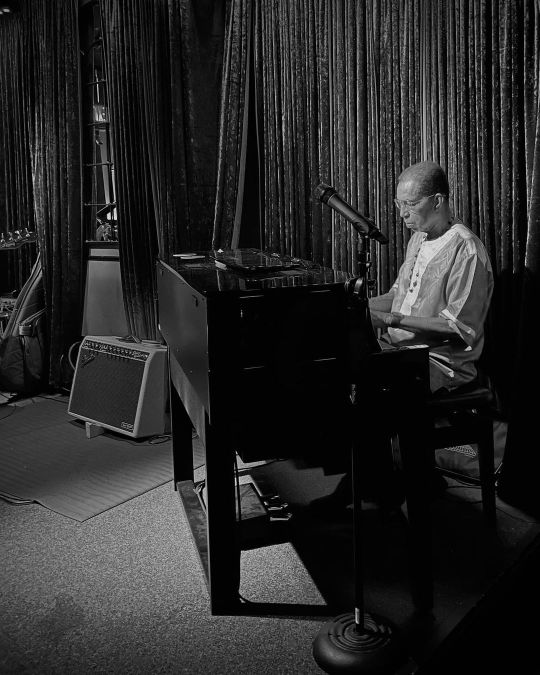
First time out to listen jazz the way it was Intended in intimate club downtown. @conalmapgh is a wonderful setting with excellent drinks and good food but the jazz is what seals the deal. Last evening they celebrated 3 years (1 year downtown) with a tribute to the great jazz Pianist with Pittsburgh roots Ahmad Jamal featuring Dr. James Johnson (slide 1), Alton Merrell, Cliff Barnes (slide 2), and Howe Alexander(slide 3). Providing the distinctive rhythm section was drummer James Johnson III, bassist Dwayne Dolphin. We were there to celebrate my wife @jennifer.pesci birthday so I hadn’t planned to make any photos but the vibe and the ambiance I spired me to make a few frames to remember the night that Jamal’s notes floated down Penn Avenue. #richardkellyexperience #richardkellyportraits #environmentalportraitswithstyle #shotoniphone #jazzmusic #pittsburghjazz (at Con Alma Downtown) https://www.instagram.com/p/CfyuahWr_vD/?igshid=NGJjMDIxMWI=
#richardkellyexperience#richardkellyportraits#environmentalportraitswithstyle#shotoniphone#jazzmusic#pittsburghjazz
7 notes
·
View notes
Text
The Pittsburgh Musicians’ Union Merger: “It Revolves Around Representation”
This post was written by Char Pyle (Fall 2021 Undergraduate Intern).


(Above) Pages from the program of the AFM’s 1962 Annual Convention, hosted at the Civic Arena in Pittsburgh. American Federation of Musicians, Local 60-471, Pittsburgh, Pa. Records, 1906-1996, AIS.1997.41, Archives & Special Collections, University of Pittsburgh Library System.
The American Federation of Musicians (AFM) is a labor union representing musicians across the country. The Pittsburgh Musicians’ Union, Local 60-471 of the AFM, has a particularly storied history. Local 60 was formed in 1897, one year after the AFM was founded. In 1908, Local 471 was created for black musicians in Pittsburgh. The two locals merged in 1966 following an integration order from the AFM. While the integration seems like it could be a positive thing, this only meant it would be more difficult for black musicians to advocate for themselves and be heard. This is evident even in the meeting minutes between both locals surrounding the merger. This interaction is noted at the beginning of the meeting:
“Before considering items, Pres. Davis asks: ‘How can we meet on common ground? What do we need? (to effect agreeable merger)’ Pres. Westray answers: ‘It revolves around representation.’”
This emphasis on representation is visible in Local 471’s proposals during the merger. Policies proposed by Local 471 included suggestions of affirmative action, shown in “Exhibit D” under “Negro Representation in Elective Offices of the Merged Union”. They sought out guaranteed representation in elected office, as they were likely not hopeful that they would truly be perceived as equals by the majority-white membership base of the merged union. Unfortunately, this has proved to be true. Since the merger, and still today, leadership of Local 60-471 is primarily white. Based on these minutes, it appears these suggestions were heavily contested and subsequently dismissed by members of Local 60. One of their arguments was that this was “a type of segregation in reverse”. This shouldn’t be an unfamiliar idea, as similar arguments are still echoed today in the realms of employment and education.

(Above) Exhibit D in the merger meeting minutes between the executive boards of both locals. American Federation of Musicians, Local 60-471, Pittsburgh, Pa. Records, 1906-1996, AIS.1997.41, Archives & Special Collections, University of Pittsburgh Library System.
Another result of the merger is the lack of records from Local 471. There is significantly more material available for Local 60, including film reels, publications, meeting minutes, photographs, and various booklets. It’s not clear why this discrepancy exists, but Local 471’s records may have simply been overshadowed as the merged union was mostly made up of former Local 60 members. This could have led to the merged local being viewed as simply a continuation of the white local, devaluing the preservation of artifacts related to Local 471. The merger also caused many black members to become disillusioned with the union, so there wouldn’t have been many people interested in preserving those records anyway. The effects of this lack of preservation were apparent almost immediately, as membership cards for many Local 471 members were lost in the merger. This led to a discontinuation of seniority benefits (even though the opposite was promised in the merger minutes), which caused many to cancel their memberships.
It’s difficult to say whether much would have changed had these policies been approved. Perhaps with more of a presence in the administration of the union, Local 471 would have retained more of its membership and its history would have been better preserved. When so many former Local 471 members resigned, they lost the ability to play music in Pittsburgh. The city may have missed out on countless performances and talented artists because of this. Unfortunate as it may be, this event was a milestone for black musicians in Pittsburgh, and greatly shaped the landscape of Pittsburgh music as a whole. This collection would be of use to those researching local musicians from the 20th century. Prominent figures that were members of Local 471 include the following, and membership cards are available for each:
Carl Arter (President)
George Benson
Art Blakey
Ray Brown
Roy Eldridge
Erroll and Linton Garner
Walter Harper
Joe Harris
Earl Hines
Roger Humphries
Ahmad Jamal
Grover Mitchell
Horace Parlan
Stanley Turrentine
Joe Westray (President at time of merger)
Mary Lou Williams
Ruby Younge Hardy (Secretary-Treasurer)
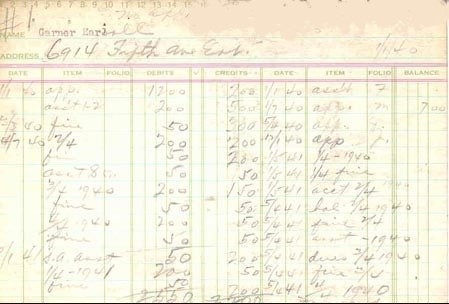

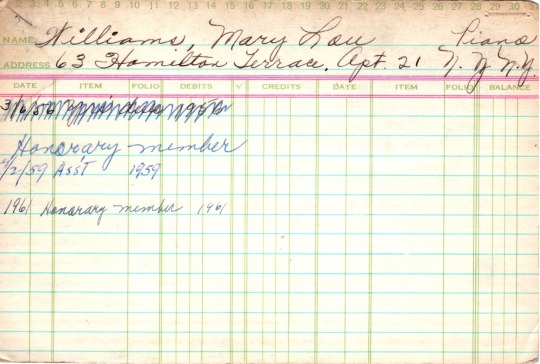
(Above) Membership cards (from top to bottom) of Art Blakey, Erroll Garner, and Mary Lou Williams. American Federation of Musicians, Local 60-471, Pittsburgh, Pa. Records, 1906-1996, AIS.1997.41, Archives & Special Collections, University of Pittsburgh Library System.
Additional Sources:
http://jazzburgher.ning.com/profiles/blogs/old-mon-music-pittsburgh-blog
https://www.afm.org/about/history/
https://www.afmpittsburgh.com/a01-aboutus.html
http://exhibit.library.pitt.edu/labor_legacy/MusiciansHistory471.htm
American Federation of Musicians, Local 60-471, Pittsburgh, Pa. Records, 1906-1996, AIS.1997.41, Archives & Special Collections, University of Pittsburgh Library System
2 notes
·
View notes
Photo
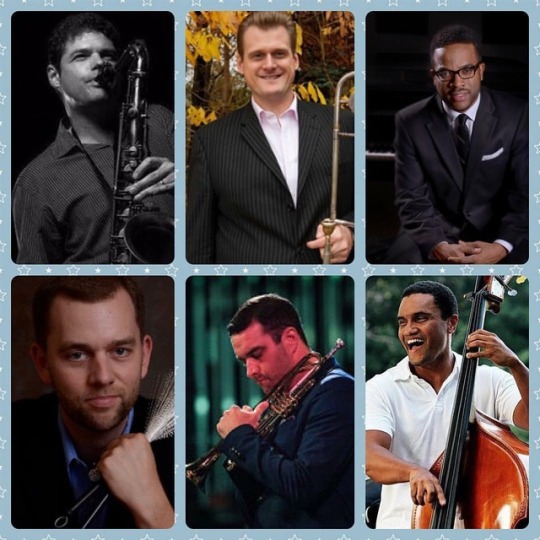
Looking forward to playing with these world class musicians this Sunday (2/25) at Alphabet City on the North Side as part of the new Off Minor Jazz Series. We play from 6-8PM. Please visit: www.alphabetcity.org to reserve your FREE seat. Hope to see you there! @pauldavid74 @draltonmerrell @jamesmoorejazz www.firmrootsjazz.com. #jazz #pittsburghjazz #draltonmerrell #moderndaydavid #blackhistorymonth #music #alphabetcitypittsburgh #americanmusic
#jazz#blackhistorymonth#alphabetcitypittsburgh#pittsburghjazz#americanmusic#draltonmerrell#moderndaydavid#music
0 notes
Photo
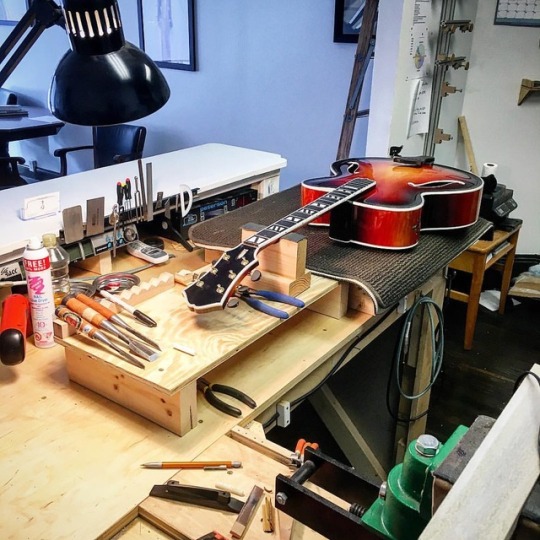
My fretwork and tone upgrades are earning a place in the world. This one came to from 5,000 miles away for a fret job and for me to re-engineer the factory bridge for improved tone. . . . . #pittsburgh #pennsylvania #pittsburghmusic #pittsburghjazz #archtop #acoustic #guitar #guitarrepair #repair #smallbusiness (at Pittsburgh, Pennsylvania)
#pittsburghmusic#guitarrepair#guitar#smallbusiness#pittsburghjazz#archtop#pittsburgh#pennsylvania#acoustic#repair
0 notes
Text
bluenoterecords: .MarcusMiller959 makes 3 US appearances this month before kicking off his European tour in July. Find his new album #LaidBlack here: https://t.co/I0Uk8W8F7l June 11: SFJAZZ, San Francisco, CA June 15: PittsburghJazz, Pittsburgh, PA Jun… https://t.co/izLJ7hkRr2 http://twitter.com/BlueNoteVinyl/status/1004794670034161666 BlueNoteVinyl
bluenoterecords: .MarcusMiller959 makes 3 US appearances this month before kicking off his European tour in July. Find his new album #LaidBlack here: https://t.co/I0Uk8W8F7l
June 11: SFJAZZ, San Francisco, CA
June 15: PittsburghJazz, Pittsburgh, PA
Jun… pic.twitter.com/izLJ7hkRr2
— Blue Note Collector (@BlueNoteVinyl) June 7, 2018
from Twitter https://twitter.com/BlueNoteVinyl
June 07, 2018 at 02:38PM
via IFTTT
1 note
·
View note
Photo
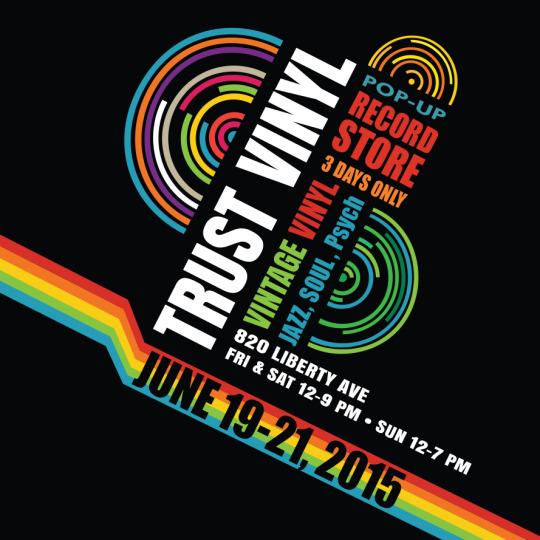
Trust Vinyl is a part of this year's Pittsburgh JazzLive International Festival in the Downtown Cultural District. This is a three day pop-up record store event taking place at 820 Liberty Ave (next to Space Gallery). This is an unoccupied store front located at the intersection of Liberty Avenue and 9th Street, behind where the 9th Street stage will be located.
Vendors will be selling vintage vinyl records during three days of live music performances on outdoor stages.
THREE DAYS ONLY!
Friday, June 19th: 12-9 PM
Saturday, June 20th: 12-9 PM
Sunday, June 21st: 12-7 PM
More information about Pittsburgh JazzLive International Festival is available at: http://trustarts.org/jazzlivefest
RSVP on Facebook:
https://www.facebook.com/events/1454828891497598
Interested in selling vinyl? Contact J. Malls ([email protected])
#Pittsburgh#PittsburghJazz#DowntownPgh#Jazz#Vinyl#PopUpStores#PittsburghJazzLive#PittsburghJazzLiveInternationalFestival#PJLIF#PghJazzFest#Records#Vintage
0 notes
Photo

Final Lineup for the March 21 Performance Just Announced!
Roger Humphries, Tony Campbell, Howie Alexander, Tim Stevens,
Joe Badaczewski, Ron Horton, Lou Stellute, Bobby Jones Jr. and Eva Lintz showcasing the music of Billy Eckstine and sharing their stories about
jazz in Pittsburgh. You do not want to miss this!
#Jazz#PghJazz#PittsburghJazz#Steeltown#SteeltownJazz#SteeltownJazzStorytellers#Pittsburgh#Pgh#JamesStreet#NorthSide
0 notes
Text
Drama in Paris
This post was written by Adam Lee, graduate student, Jazz Studies.
On December 2, 1957, Erroll Garner’s trio flew to Paris, France for an extended engagement. Garner’s manager Martha Glaser arranged via telegram for Bruno Coquatrix of the Olympia Theater to make arrangements for Garner, Eddie Calhoun, and Kelly Martin. The tour was apparently arranged by Russian-born American impresario Sol Hurok but outsourced to a French division of the Dutch company, Philips. According to bassist Calhoun, as quoted in James Doran’s Garner biography, this tour went well:
She [Martha Glaser] must have respected him [Sol Hurok] very highly because we never had any problems. Erroll was under Sol's concert tour for two years, somewhere in 1957-59. During that time it was a pleasure because everything was first class: traveling, hotels, etc. We were still under Sol Hurok when we went to Europe. They have their own impresarios over there like they do here, and then they hook you up to one of the offices that they are affiliated with, and then you go under them over there. When we were in Europe, we were always under the booking office of Philips. Philips usually handled our whole tour, and then they subcontracted out along the way, but it was still under Philips' tour (Doran 1985, 92).
There must have been some drama on the organizational side of things however, as shortly after Garner’s arrival in Paris, his manager Martha Glaser sent a handful of scathing telegrams to various people telling them in no uncertain terms of her displeasure in some aspect of how the companies were handling Garner on the French side. The first target of her ire was Aram “Al” Avakian, brother of Columbia Records producer George Avakian, whom she telegraphed on December 6, 1957.

Image from folder “Telegrams,” Erroll Garner Archive, 1942-2010, Box 3, Folder 1, Archives & Special Collections, University of Pittsburgh Library System.
This telegram—which is admittedly difficult to parse due to the nature of telegram correspondence—contains language such as “Your goof cost me every deadline and break in town nice work,” imparting a very sarcastic and aggressive tone. It ends with the very disappointed “I depended on you.” Kelly Martin also sent Glaser a handwritten letter from France at some point on the tour, in which he says, “Al is a very nice fellow, but he don’t know the angles to get things done.” While the letter is undated, one can expect that international mail correspondence is slower than telegram transmission, and likely Glaser would not have received this letter prior to sending her critical telegram.
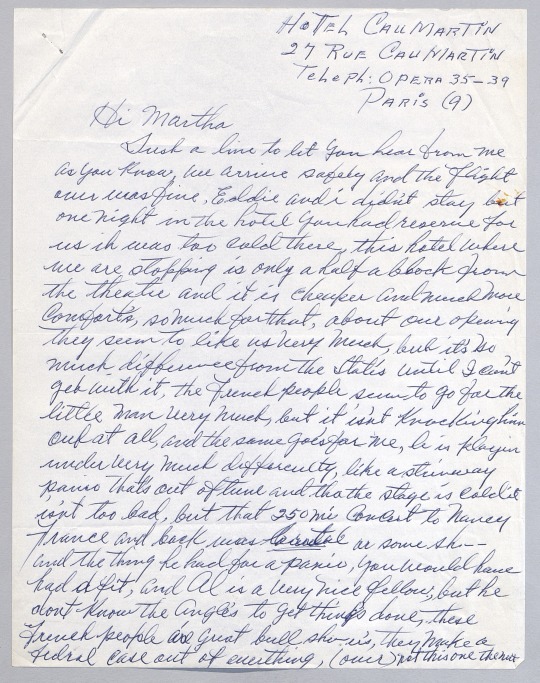
Image from folder “Martha Glaser Incoming Correspondence,” Erroll Garner Archive, 1942-2010, Box 69, Folder 8, Archives & Special Collections, University of Pittsburgh Library System.
Glaser’s second telegram is dated two days later, December 8, 1957 to Goddard Lieberson, President of Columbia Records. This note provides additional detail as to the circumstances of Glaser’s disappointment in Avakian. The Philips company had mishandled Garner; some of the ways this played out is shown in Irene Monteverde’s 2017 thesis on this tour. Glaser implies that Garner was to be presented at the Olympia Theatre, but the Philips company’s representative Jacques Canneti had a stake in the Alhambra Theatre’s success and perhaps failed to promote the Garner concerts appropriately. Glaser asks Lieberson to step in directly to put Columbia’s weight behind her grievance and specifies that if Philips cannot uphold their part of the contract then another label should take over handling Garner in France.
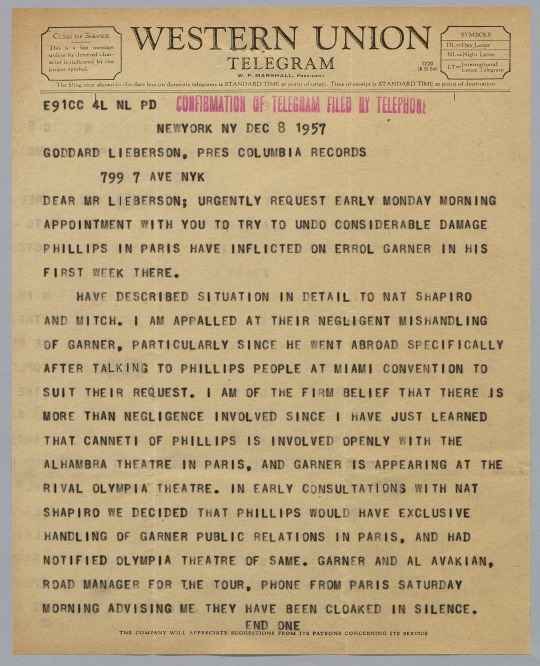
Image from folder “Telegrams,” Erroll Garner Archive, 1942-2010, Box 3, Folder 1, Archives & Special Collections, University of Pittsburgh Library System.
Glaser subsequently sent a pair of further telegrams to Avakian, asking him to contact Gene Moskowitz, an American working for the Paris bureau of the entertainment magazine Variety. Moskowitz would be taking over promotional activity for the Garner tour from that point on, with Glaser requesting that Avakian and Garner “treat him like [sic] friend” since he “knows everyone in show business in Paris.” She seems to have forgiven Avakian for the initial mishaps by this time, signing this telegram with a casual post-script “Columbia top brass checking Phillips goof. Will advise, keep cool and swinging, everything will work out” [punctuation mine].
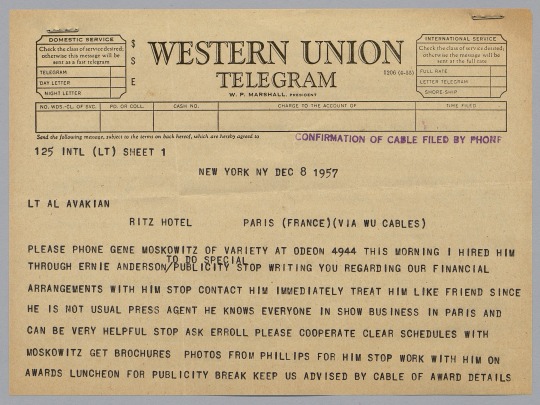
Image from folder “Telegrams,” Erroll Garner Archive, 1942-2010, Box 3, Folder 1, Archives & Special Collections, University of Pittsburgh Library System.
Eventually everything seems to have been smoothed over on a surface level, as a few days later (December 10) Glaser sent a telegram which states that Garner was to receive the prestigious “Grand Prix du Disque” award, which she claims is “equivalent to our Academy Award.” She also notes that Garner was “currently headlining at [the] Olympia Theater through December 26…concert dates already sold out.” It is impressive to see how quickly Glaser rose to fight for her client, despite being an ocean away, and managed to smooth out the business side. In a subsequent December 21 letter to someone named only as “Frances,” Glaser indicates that Garner himself was quite disquieted by the events at the Olympia, including a fear of unauthorized recordings of the Olympia sessions.
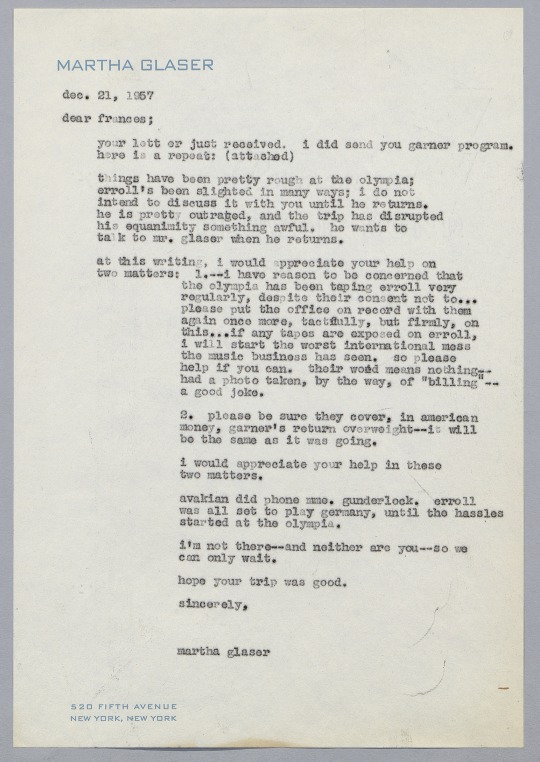
Image from folder “Martha Glaser Outgoing Correspondence 1957,” Erroll Garner Archive, 1942-2010, Box 68, Folder 8, Archives & Special Collections, University of Pittsburgh Library System.
Much of this information can be seen laid out in Monteverde’s thesis, including information on the leadup to this tour as well as further details about the tour outside Paris, so for additional context it is highly recommended to follow up with a close reading of that document.
Work Cited
James M. Doran, Erroll Garner: The Most Happy Piano (Metuchen, NJ: Scarecrow Press, 1985), 83-5.
Erroll Garner Archive, 1942-2010, AIS.2015.09, Archives & Special Collections, University of Pittsburgh Library System.
Monteverde, Irene. “Paris Impressions: Critics and Gimmicks in the Art World of Erroll Garner, 1957-58”. Thesis (MA) –University of Pittsburgh, 2017.
10 notes
·
View notes
Text
Memories Arise, Digging in the Archive
This post was written by Warner Sabio Sr., Graduate Student, Jazz Studies, University of Pittsburgh.
On October 16, 1959, Pittsburgh pianist Erroll Garner made a pivotal Carnegie Hall appearance. The concert was sold-out, and his tune “Misty,” performed by both Johnny Mathis and Sarah Vaughan, was climbing the charts. Accompanied by bassist Eddie Calhoun and drummer Kelly Martin, Garner worked his magic. According to Billboard Magazine’s Bob Rolontz, in a review of the concert, “There are few pianists, even including classical artists, who can pack a hall the size of Carnegie and also carry an entire concert alone. … Garner was at his peak for this performance,” (Rolontz, 16). Despite a lukewarm review from the New York Times (Wilson, 26), the concert was an overall success, and Garner must have been feeling pretty good.
On that day at 2:44 p.m., Garner’s manager, Martha Glaser, received a telegram from a person identified only as “Debbie.” Perhaps a friend, the telegram sent a straightforward message of good luck on the cusp of the performance: “Congratulations on your Carnegie Hall stage mother debut, Bestest, Debbie.”
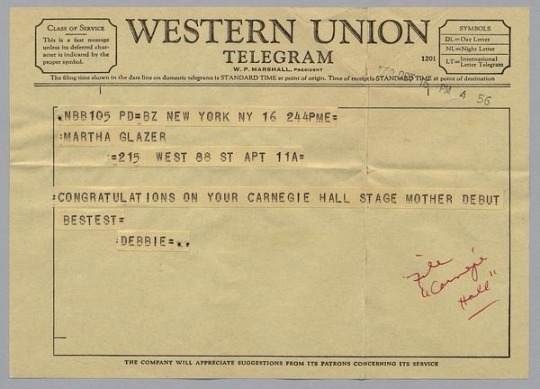
Image from folder “Telegrams,” Erroll Garner Archive, 1942-2010, Box 3, Folder 1, Archives & Special Collections, University of Pittsburgh Library System.
Interestingly, four days later, Debbie sent another telegram, this time expressing a very different sentiment: “Cops is cops but Garner is Garner and Glaser is Glaser and we still love you both.”.
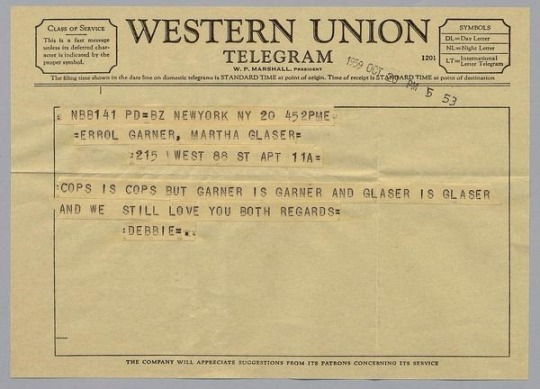
Image from folder “Telegrams,” Erroll Garner Archive, 1942-2010, Box 3, Folder 1, Archives & Special Collections, University of Pittsburgh Library System.
It was the words “cops is cops,” that stopped me in my tracks and aroused unsettled emotions within me. Those words made me wonder if Garner had experienced a situation with the police in 1959.
Earlier that year, on August 25, fellow jazz musician Miles Davis was involved in an incident with New York City police officers. The episode took place just a few blocks from Carnegie Hall, right outside of the Manhattan jazz club Birdland, where Davis was headlining that night. According to Davis, a police officer threatened to arrest him after asking him to relocate. Davis informed the officer that he was performing at the club and saw no reason to move. The officer went to arrest Davis; however, before he could, another officer hit Davis over the head with an object. Davis was arrested, and the altercation left him bloody and hurt (Matthews, 1).
“Cops is cops.” I had heard words similar to these when I was a child. An older cousin sat me down along with my older brother, Rudy—who must have been eleven at the time—to discuss the importance of “keeping safe” in New York City. He asserted, “Cops will be cops” and that we needed to be very careful in dealing with the police; otherwise, things could turn out badly if not fatal. My nine-year-old self did not fully comprehend this message, and I was left confused. Four years later, I would completely understand this warning.
In the fall of 1984, as I returned home from school, I was confronted by a New York City police officer. I was waiting in a stairwell for the number 7 train as wind and rain pounded the elevated platform. The officer asked me to, “Get off the stairs and go up to the platform.” I explained that I was simply seeking some shelter, and when the train arrived, I would move on. I made the mistake of suggesting that he was doing the same. It would be ridiculous for him to keep safe and dry while I, a child, risk getting wet and potentially become ill. The suggestion elicited laughter from two classmates of mine who took the same train home and were standing nearby on the stairwell. Now only two feet away, the officer drew his service revolver. He pointed the pistol at me: “Now, I’m sure you won’t mind standing on the platform, right?” The other two students and I quickly moved to the platform, and thankfully the train soon arrived.
We did not speak for most of the trip home, only to say goodbye as we transferred for other trains at 42nd Street. We continued to ride the subway home together throughout the year, but we never spoke of the incident. Seven years ago, at the age of 43, I finally told my parents about my encounter with the police on that day. I held back telling them for years because I did not want them to worry. But who am I kidding? They worried then and they still worry now.
The circumstances surrounding Debbie’s telegram are not specified. The telegram alone does not provide enough information even to speculate as to what she meant by the phrase, “cops is cops.” Perhaps other bits of information can be found in the archive that can shed light on this event. If so, that would be great. If not, I think it is still fruitful to ponder Garner’s ability to navigate his success while simultaneously negotiating the harsh realities of intolerance, racism, and discrimination.
Works Cited
Matthews, Les. “‘It Was Police Brutality’: Miles Davis' Own Story: They Beat on My Head Like A Tom – Tom.’” New York Amsterdam News, Aug 29., 1959, p. 1.
Rolontz, Bob. “Concert Review: Garner Great in Carnegie Debut.” The Billboard, Oct. 26, 1959, p. 16.
Wilson, John S. “Erroll Garner, Jazz Pianist, Plays Carnegie Hall Program.” The New York Times, Oct. 17, 1959, p. 26.
9 notes
·
View notes
Text
“WILL THERE BE ANOTHER YEAR FOR US?”: Martha and Erroll’s First Anniversary
This post was written by Deanna Witkowski, pianist-composer, graduate student in Jazz Studies at the University of Pittsburgh, and author of Mary Lou Williams: Music for the Soul (Liturgical Press, August 2021).
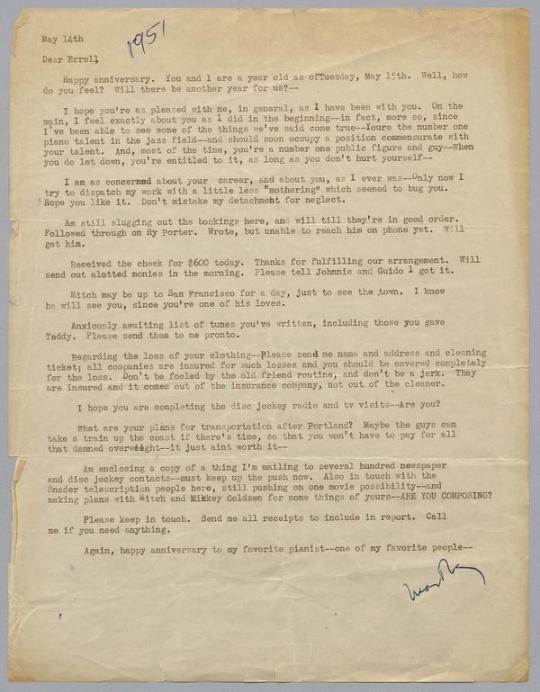
Image from folder “Correspondence between Erroll Garner and Martha Glaser,” Erroll Garner Archive, 1942-2010, Box 3, Folder 2, Archives & Special Collections, University of Pittsburgh Library System.
Martha Glaser wrote this letter to Erroll Garner on May 14th, 1951, one day shy of their first anniversary of working together as manager and artist. By this point, Glaser had been on the West Coast for ten weeks on behalf of Garner, and likely wrote to him while he was on the road with his trio. Her question, “Will there be another year for us?,” may mark a renewal point in Garner’s contract where he had to decide whether or not to continue having Glaser represent him. Without knowing the history of their initial agreement, it is just as possible that Glaser is asking her question in a half-teasing tone reminiscent of a romantic couple. Throughout the letter, Glaser takes stock of the pair’s accomplishments, states her satisfaction in their work thus far, and details the minutiae of daily work she undertakes on Garner’s behalf.
In their first year together, Garner and Glaser had established goals for the pianist’s career, goals that helped to define some of the work that Glaser undertook on his behalf. She calls Garner “the number one piano talent in the jazz field” and details how she has been working tirelessly to procure bookings, to find artists to record Garner’s compositions, and to manage some of Garner’s touring logistics. She expresses the hope that he will “soon occupy a position commensurate with [his] talent.” Indeed, just five years later, Columbia Records would release Garner’s breakout live performance recording, Concert by the Sea, which would sell over one million copies in its first three years of release. Glaser was instrumental in bringing the tapes of the live recording to Columbia executives and convincing them to release the album. While Garner had been steadily moving away from club appearances to larger concert stages, Columbia had not had the foresight to record any of his live appearances. In his liner notes to the album, Columbia producer George Avakian explains, “The reason for the delay [in a live concert release] is simple. No one ever thought of recording a Garner concert before” (George Avakian, liner notes to Concert by the Sea).
We can divide the types of labor outlined by Glaser in this letter into several categories: booking performance dates; advising Garner in regard to his composing, tour routing and finances; and inviting other performers to record Garner’s compositions.
Glaser tells Garner that she is adjusting her managerial style to accommodate him, conducting her work “with a little less ‘mothering.’” Yet she also has to take on the necessary role of prodding Garner: she is waiting for him to send a list of his original compositions, presumably so that she can share them with other artists. Towards the close of the letter she asks Garner, in all caps, “ARE YOU COMPOSING?” She also thanks him for sending a $600 check to fulfill their business agreement (leaving the details vague). In a separate letter dated two months later on June 17, Garner authorizes further payment to Glaser of $900 in back salary, as well as reimbursement for “all of her travel, housing, and publicity expenses since leaving New York City for the West Coast” on March 28. Later on in their relationship, Garner would have more direct authorization of Garner’s financial accounts, but in 1951, she notated each detail of financial business to Garner.
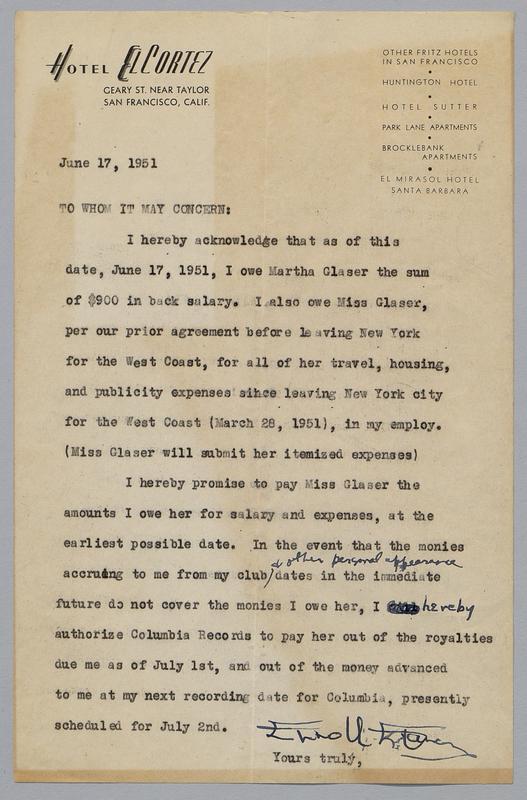
Image from folder “ Correspondence between Erroll Garner and Martha Glaser,” Erroll Garner Archive, 1942-2010, Box 3, Folder 2, Archives & Special Collections, University of Pittsburgh Library System.
Glaser also takes on the role of financial adviser when mishaps arise on the road. Glaser assures Garner that a cleaning company that ruined his clothes must be insured, asks him to send a receipt, and advises him to not “be a jerk” about the affair. She also suggests that Garner have his side musicians take a train from Portland to avoid overweight charges (probably related to flight charges for a drum kit and an acoustic bass enclosed in a heavy travel case).
It seems surprising that if Glaser was indeed functioning as Garner’s tour manager as well as his business manager that certain details were not under her purview, such as the choice of travel from Portland. Perhaps—as this was still only a year into their professional relationship—Garner had given her control over some aspects of his professional work, but withheld others. Glaser also asks if Garner is fulfilling his scheduled in person radio and television visits, something that would again be taken care of by a tour manager. Imagining Glaser overseeing all of these details while not traveling with her client gives a sense of the many obligations that both she and Garner had to fulfill on a daily basis.
In many ways, Glaser’s role as artist manager is similar to that of a bandleader: articulating a vision; negotiating different personalities in the service of that vision; and juggling many non-musical details that make stepping onto the stage possible. From this letter, it is apparent that Glaser is working relentlessly for Garner. Going deeper into the archives, it is my hope that we will learn more from Garner regarding his feelings toward Glaser and will understand more fully the uniqueness of this particular decades-long relationship between manager and artist.
Work Cited
George Avakian, liner notes to Erroll Garner, Concert by the Sea (Columbia Records, 1956). CD and LP. Accessed February 9, 2021. https://www.cdandlp.com/en/erroll-garner/concert-by-the-sea/lp/r117444600. Permalink: https://perma.cc/32JV-NXMT
4 notes
·
View notes
Text
Garnering Erroll’s Universe of Things
This post was written by YuHao Chen, graduate student in ethnomusicology, University of Pittsburgh.
On January 2nd, 1977, as he was making his way to the hospital, famed jazz pianist Erroll Garner collapsed in the lobby of his apartment building in Beverly Hills, California. Garner died of lung cancer, a condition that had significantly interfered with his performance career since 1975. His death stirred ripples of attention across the jazz world. Condolences resounded among his admirers. Deeply felt words, especially those from within his intimate circle, were expressed in gravity. Martha Glaser, Garner’s manager who championed his career for nearly three decades, confided later that month to his neighbor Beatrice Glass, “I am too weary to say much—except to thank you.” Gratitude, sorrow, and silence were mortared onto paper-thin records following Garner’s passing.
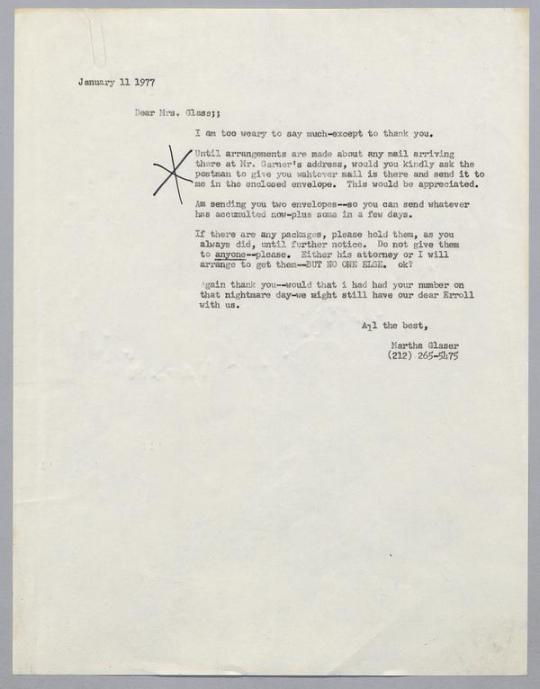
Image from folder “Erroll Garner Estate,” Erroll Garner Archive, 1942-2010, Box 3, Folder 22, Archives & Special Collections, University of Pittsburgh Library System.
Amidst these heavy, withheld sentiments was a little-known agitation that occurred in Garner’s apartment two days after his death. On January 4th, as his body was being transported under his brother Linton’s supervision from Los Angeles to Pittsburgh, a ruckus broke out surrounding a quotidian collection of items at 815 S. Shenandoah, Apartment 203. They were moved, shuffled, picked over, turned, unsettled for an unknown duration, only to be duly rearranged—at the very end—onto an itemized list. Over the next several months, the inventory would develop in size and detail, forming an initial basis for what would become the Erroll Garner estate.
The preliminary inventory compiled on January 4th, 1977 offers a glimpse into Garner’s habitat during the final hours of his life. Written with two different pens—one taking the initial round of survey, the other specifying the quantities of items and missing details—this document is preserved in the Erroll Garner Archive as a photocopied record, with a subtle folded line cleaving the phrase “1,200 cassette tapes.” This list represents the very first, albeit incomplete, look at the physical environment Garner left behind.

Image from folder “Erroll Garner Estate,” Erroll Garner Archive, 1942-2010, Box 3, Folder 22, Archives & Special Collections, University of Pittsburgh Library System.
While we do not know who penned the inventory, later correspondence from Martha Glaser suggests that the task of handling Garner’s personal belongings and incoming mails was shared among a group of people. For the remainder of 1977, these orphaned objects were looked after by Garner’s neighbor Beatrice Glass, his sister Ruth Garner Moore, realtor Ursula Fox, attorneys Howard E. Lowe and Sidney Horvitz, and Glaser herself, among others.
The cataloging effort continued into April that year. The April 16th inventory, which took three days for two attorneys and Garner’s sister to complete, is a comprehensive documentation of Garner’s California dwelling. Spanning nine neatly typed pages, it enumerates items from all his living quarters: the den (with separate sections on the desk, credenza, and closet), patio, living room, dining room (and cabinets), kitchen, linen closet, hall closet, bedroom, and master bathroom. In addition, there is an inventory of Garner’s wardrobe compiled by his sister. Per Glaser’s request, Ruth also made annotations and underlined watches, rings, clocks, and cameras—possibly to indicate the more expensive items on the list.
As a whole, this litany of things articulates the thickness of life. The five-drawer desk in the den, for example, would surely not have taken up more space than the entire living room. Yet the desk items sprawl over three pages in the inventory; the items from the living room, on the other hand, occupy less than one. Over sixty desk items are recorded, some inconspicuously small (a pair of piano key cuff-links), others delicately light (an autographed photo from Sonny Stitt). Although the inventory does not tell us about the precise spatial arrangement of Garner’s apartment, it provides an array of objects with which we may imagine different possibilities.
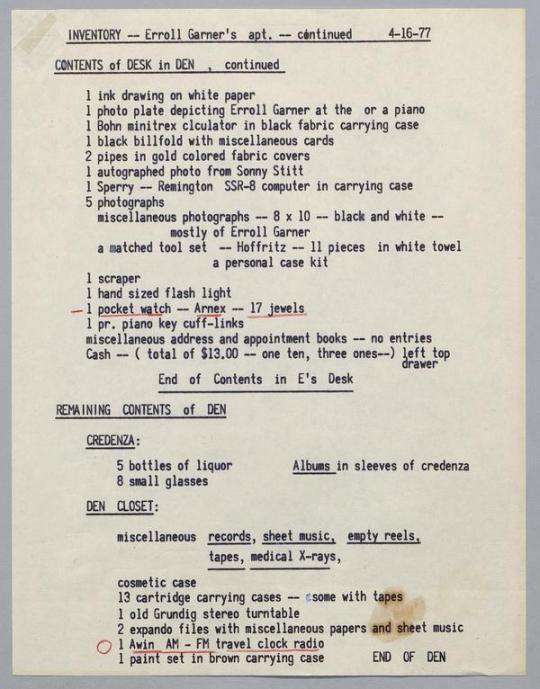
Image from folder “Erroll Garner Estate,” Erroll Garner Archive, 1942-2010, Box 3, Folder 22, Archives & Special Collections, University of Pittsburgh Library System.
In a literal sense, the objects included in the January and April inventories were some of the last witnesses and liaisons to Garner’s still living body—they shared the same air before he left the door for the hospital, endured the same physical space and overlapping histories. Garner’s presence is made vivid by the functionality of these items. They bear the traces of his final imprint, like the unattended clay that retains the shape of a long-departed palm.
With Garner’s passing, the stuff around him comes alive. His constellation of things, previously tucked away in the Shenandoah apartment, surfaces in the texture of the catalog. Through changing hands, they are indexed, appraised, negotiated, stored, sold, shipped, unboxed. As Garner’s deceased body made its homeward journey to Pittsburgh on January 4th, his belongings simultaneously took flight, beginning to pulse through various phases of inventory and, for some, preservation.
Glaser took part in orchestrating the afterlife of Garner’s belongings. Through the end of 1980, if not later, she worked scrupulously to handle and breathe new life into these inanimate things. One can only imagine the difficulty of managing the inventories from a distance. As Glaser perused these catalogs in her office in New York—anxiously, perhaps, having neither the luxury of taking her own inventory on site nor the whim of abandoning the objects on the West Coast—she had to rely on her distant collaborators. As much as she might like to look over their shoulders, Glaser’s vision was guided by the ways in which they scanned and parsed Garner’s estate. Through their organizational schema, Garner’s belongings were transformed into a table of contents, to be delivered and presented to Glaser as metadata. What Glaser was reading, in effect, was a finding aid.
After all, what is a finding aid but a catalog of things that were summoned, scrutinized, skipped over, and split? Some of Garner’s belongings were likely sold in estate sales, others stored in the archives, still others permanently lost, only to be found as names in the inventories. And these documents, as archived objects themselves, exist in yet another catalog of items within the Garner Archive. Listing, cataloging, and finding—these are gestures embedded in the very appearance of Garner’s things. Thanks to archival realism, objects can be brought into brief communion through finding aids before coming apart again. The January and April inventories, in particular, provide a frozen frame for delineating an ecology for the Garner Space and the Garner Body, a physical coherence that nonetheless disintegrates into a sea of records the moment we try to retrieve it. Affixed to a finding aid, Garner’s corpus of things cannot help but hide behind its own archival skin, ultimately remaining an index of 1977.
2 notes
·
View notes
Photo

Well look who's back home! Hi girl!!! . . . . #archtop #luthier #acoustic #guitar #smallbusiness #hardwork #pittsburgh #pittsburghjazz (at Pittsburgh, Pennsylvania)
0 notes
Photo
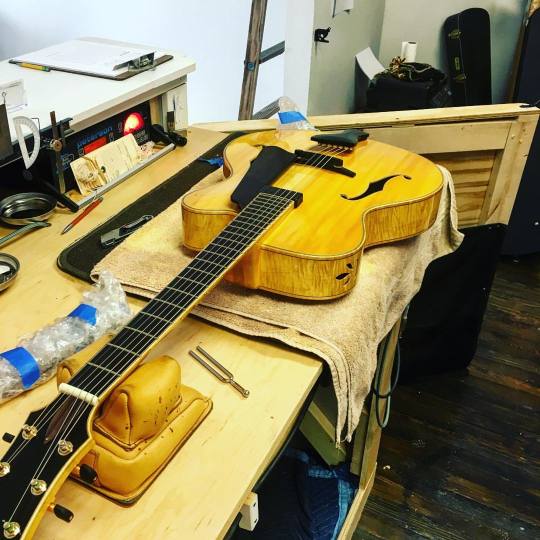
#Pittsburgh #guitarists . If people all the way from Hawaii send me their guitars for repair work.... don't you think it's worth giving my shop a shot for your instruments over guitar center? Just saying... . . . . . #guitar #repair #pittsburghmusic #pennsylvania #acoustic #archtop #jazz #pittsburghjazz #pittsburghartist #guitarrepair
#pittsburghmusic#repair#pittsburghjazz#archtop#pittsburgh#jazz#guitar#pennsylvania#pittsburghartist#guitarrepair#acoustic#guitarists
0 notes